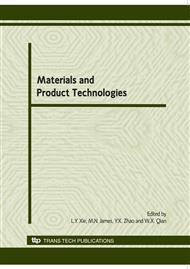p.100
p.105
p.111
p.116
p.121
p.126
p.131
p.136
p.141
Fatigue Limit Measurement of the Cast Steel for Chinese Railway Rolling Wagon Bogie Frames
Abstract:
Fatigue limit measurement is investigated experimentally on the grade B cast steel for Chinese railway freight car bogie frames. Small sample up-and-down test method was employed for the present study. Results reveal that fatigue cracks initiated mostly from the material cast shrinking cavities. Distinct river-like flowers and second cracks appeared on fracture surface in perpendicular to fatigue crack path. Lots of dimples are distributed in transient fracture district to indicate that present material is ductile. Maximum likelihood approach is applied for measuring the probabilistic fatigue limits, in which the limits are defined as the fatigue strengths following normal distribution at an expected fatigue life. Statistical parameters are then estimated by a likelihood function method. A comparison analysis to the existent conventional, Dixon-Mood and Zhang-Kececioglu approaches indicates that the maximum likelihood approach is the approach meeting the definition.
Info:
Periodical:
Pages:
121-125
Citation:
Online since:
June 2010
Authors:
Keywords:
Price:
Сopyright:
© 2010 Trans Tech Publications Ltd. All Rights Reserved
Share:
Citation:


